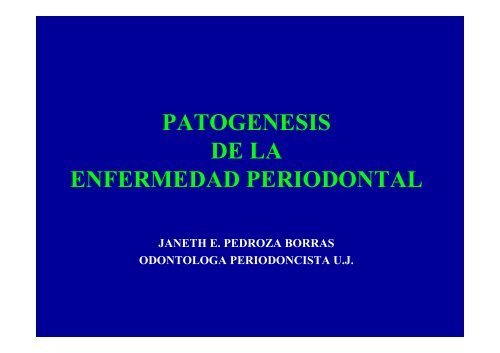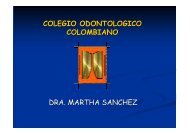PATOGENIA DE LA ENFERMEDAD PERIODONTAL
PATOGENIA DE LA ENFERMEDAD PERIODONTAL
PATOGENIA DE LA ENFERMEDAD PERIODONTAL
- No tags were found...
Create successful ePaper yourself
Turn your PDF publications into a flip-book with our unique Google optimized e-Paper software.
<strong>PATOGENIA</strong>• Parte de la medicina que estudia el origen yel desarrollo de las enfermedades.Diccionario de la Lengua Española, Barcelona, 2001.• Causa y evolución de una enfermedad otrastornoDiccionario de medicina, 2001, España, Instituto Científico y Tecnológico de laUniversidad de Navarra.
GINGIVITIS Y PERIODONTITIS• REACCION INF<strong>LA</strong>MATORIA- MICROSCÓPICAMENTE- CLÍNICAMENTE• REACCION INMUNITARIA-A <strong>LA</strong> MICROFLORA Y SUS PRODUCTOS
P<strong>LA</strong>CA BACTERIANACOMPONENETESCARACTERISTICASHUESPEDMECANISMO <strong>DE</strong> RESPUESTACAMBIOS PATOLOGICOS<strong>DE</strong> LOS TEJIDOS
PROCESOSINF<strong>LA</strong>MATORIOS E INMUNESBENEFICOS• PROTEGEN ANTE EL ATAQUE BACTERIANO– EVITAN• EXTENSION• INVASION TISU<strong>LA</strong>RPERJUDICIALES• DAÑO TISU<strong>LA</strong>R Y CELU<strong>LA</strong>R
PROCESOSINF<strong>LA</strong>MATORIOS E INMUNESDIFERENCIA SIGNIFICATIVA CON <strong>LA</strong>INF<strong>LA</strong>MACION EN OTRAS PARTES <strong>DE</strong>L CUERPO•EPITELIO <strong>DE</strong> UNIONDINAMICA CELU<strong>LA</strong>RDINAMICA <strong>DE</strong> FLUIDOS•RESPUESTA A MULTIPLESMICROORGANISMOSY SUS PRODUCTOS (Myrand,1985)•TIEMPO PROLONGADO
PROCESOSINF<strong>LA</strong>MATORIOS E INMUNESVIRULENCIAM.O.CAPACIDAD <strong>DE</strong> RESPUESTA<strong>DE</strong>L HUESPEDINF<strong>LA</strong>MACION<strong>DE</strong>STRUCCION <strong>PERIODONTAL</strong>REACCIONINMUNITARIAENZIMASBACTERIANASPRODUCTOS <strong>DE</strong> <strong>DE</strong>SECHOLIPOPOLISACARIDOS <strong>DE</strong> MEMB<strong>DE</strong> GRAM NEGATIVOS
• <strong>LA</strong> EXPERIENCIA Y EXTENSIONAUMENTA CON <strong>LA</strong> EDAD Y CON <strong>LA</strong>INA<strong>DE</strong>CUADA HIGIENE ORAL.• <strong>LA</strong> <strong>ENFERMEDAD</strong> <strong>PERIODONTAL</strong> ESTARE<strong>LA</strong>CIONADA CON EL SUJETO. SOLOALGUNAS PERSONAS SUFREN<strong>DE</strong>STRUCCION• <strong>LA</strong> PROGRESION ES LENTA Y CONTINUACON EPISODIOS <strong>DE</strong> EXACERBACIÓN YREMISION
ETIOLOGIA INFECCIOSAGINGIVITISPERIODONTITISSaxe y col, 1967 / Lindhe y col.,1975
CARACTERISTICAS CLINICAE HISTOPATOLOGICAS <strong>DE</strong><strong>LA</strong> ENF. <strong>PERIODONTAL</strong>• ENCIA NORMAL– CLINICAMENTE:• COLOR ROSADO• CONSISTENCIA FIRME• MARGEN CONTORNO FESTONEADO• PAPI<strong>LA</strong>S FIRMES• NO SANGRA• LLENAN ESPACIOS PROXIMALES• PUNTEADO GINGIVAL• MARGEN EN FILO <strong>DE</strong> CUCHILLO
Encía sana– SUPER SANA PRISTINA– CLÍNICAMENTE SANAInfiltrado inflamatoriode hasta un 5% del volumendel tejido conectivo
Encía sana• FACTORES <strong>DE</strong>FENSIVOS– EFECTO ANTIBACTERIANO <strong>DE</strong>LOS ANTICUERPOS– FUNCION FAGOCITARIA <strong>DE</strong> LOSNEUTROFILOS Y MACROFAGOS– <strong>DE</strong>SCAMACION <strong>DE</strong> EPITELIOS– BARRERA EPITELIAL INTACTA– FLUJO POSITIVO <strong>DE</strong> FLUIDOCREVICU<strong>LA</strong>R
• INF<strong>LA</strong>MACION GINGIVAL ES RESULTADO<strong>DE</strong> SOBREGARGA <strong>DE</strong> BACTERIAS POR UNESCASO CONTROL <strong>DE</strong> P<strong>LA</strong>CA• <strong>LA</strong> ALTERACION <strong>DE</strong>L SISTEMAINMUNITARIO PUE<strong>DE</strong> RESULTAR ENINF<strong>LA</strong>MACION GINGIVAL MANIFIESTA• <strong>LA</strong> PERIODONTITIS CRONICA REQUIERECIERTA PREDISPOSICION
CARACTERISTICAS• ENROJECIMIENTOCLINICAS• TUMEFACCION TEN<strong>DE</strong>NCIA ALSANGRADO• TEXTURA B<strong>LA</strong>NDASIGNOS REVERSIBLES <strong>DE</strong>SPUES<strong>DE</strong> <strong>LA</strong> ELIMINACIÓN <strong>DE</strong> P<strong>LA</strong>CABACTERIANALINDHE Y RY<strong>LA</strong>N<strong>DE</strong>R,1975
FASES <strong>DE</strong>L PROGRESO <strong>DE</strong><strong>LA</strong> LESION <strong>PERIODONTAL</strong>• LESION GINGIVAL INICIAL• LESION GINGIVAL TEMPRANA• LESION GINGIVAL ESTABLECIDA• LESION GINGIVAL/PERIODONTA<strong>LA</strong>VANZADAPAGE Y SCHROE<strong>DE</strong>R 1976
LESION GINGIVAL INICIAL– 24 HORAS <strong>DE</strong> ACUMULO <strong>DE</strong> P.B.– DI<strong>LA</strong>TACIÓN <strong>DE</strong> ARTERIO<strong>LA</strong>S,CAPI<strong>LA</strong>RES Y VENU<strong>LA</strong>S– AUMENTA PRESION HIDROSTATICA <strong>DE</strong><strong>LA</strong> MICROCIRCU<strong>LA</strong>CION– BRECHAS ENTRE CELU<strong>LA</strong>SENDOTELIALES ADYACENTES– AUMENTA <strong>LA</strong> PERMEABILIDADVASCU<strong>LA</strong>R– LIQUIDOS Y PROTEINAS HACIA LOSTEJIDOS
LESION GINGIVAL INICIALFLUIDO CREVICU<strong>LA</strong>R GINGIVAL• PROTEINAS <strong>DE</strong> <strong>DE</strong>FENSA– ANTICUERPOS– COMPLEMENTO– MACROMOLECU<strong>LA</strong>SMARCADORESPROCESOINF<strong>LA</strong>MATORIOEL VOLUMEN <strong>DE</strong>L EXUDADO ESPROPORCIONAL A <strong>LA</strong>SEVERIDAD <strong>DE</strong> <strong>LA</strong> INF<strong>LA</strong>MACION
LESION GINGIVAL INICIAL• <strong>LA</strong> RESPUESTA CELU<strong>LA</strong>R ESTABIEN ESTABLECIDA AL CUARTODÍA• SUSTANCIAS QUIMIOTACTICAS<strong>DE</strong> <strong>LA</strong> MICROFLORA• LOS LEUCOCITOS SE MUEVEN ATRAVES <strong>DE</strong>L T. CONECTIVOHASTA EL E. UNION Y EL SURCO• LOS NEUTROFILOS LLEGAN ALSURCO
LESION GINGIVALTEMPRANA• AL DIA 7 <strong>DE</strong> ACUMULO <strong>DE</strong> P<strong>LA</strong>CA• DI<strong>LA</strong>TACION <strong>DE</strong> VASOSSUBEPITELIALES AUMENTAN ENNUMERO• INFILTRADO LEUCOCITARIO:LINFOCITOS Y NEUTROFILOS• POCOS P<strong>LA</strong>SMOCITOS• INFILTRADO INF<strong>LA</strong>MATORIO:15% <strong>DE</strong>L T. CONECTIVOEN VOLUMEN
LESION GINGIVALTEMPRANA• <strong>DE</strong>GENERACION <strong>DE</strong>FIBROB<strong>LA</strong>STOS• <strong>DE</strong>STRUCCION <strong>DE</strong>CO<strong>LA</strong>GENO• A <strong>LA</strong> SEGUNDA SEMANA:<strong>DE</strong>POSITOS SUBGINGIVALES• PROLIFERACION <strong>DE</strong> <strong>LA</strong>SCELU<strong>LA</strong>S BASALES <strong>DE</strong> LOSEPITELIOS
LESION GINGIVALESTABLECIDAHISTOLOGICAMENTE• AUMENTA <strong>LA</strong> INF<strong>LA</strong>MACION• AUMENTA EL FLUJO <strong>DE</strong> FLUIDOCREVICU<strong>LA</strong>R• MIGRACION <strong>DE</strong> LEUCOCITOS• A LOS TEJIDOS Y EL SURCO• PREDOMINAN LOS P <strong>LA</strong>SMOCITOS• CONTINUA <strong>LA</strong> PERDIDA <strong>DE</strong>CO<strong>LA</strong>GENO
LESION GINGIVALESTABLECIDA• INFILTRACION ELEPITELIO SULCU<strong>LA</strong>R• PREDOMINIO <strong>DE</strong>NEUTROFILOS• EPITELIO <strong>DE</strong> <strong>LA</strong>BOLSA MASPERMEABLE YULCERADO• PD O NO PROGRESAR
LESION GINGIVAL• CLINICAMENTEESTABLECIDA• MAYOR TUMEFEACCIONE<strong>DE</strong>MATOSA• PUE<strong>DE</strong> SER CONSI<strong>DE</strong>RADAGINGIVITIS ESTABLECIDA
LESION PERIODONTA<strong>LA</strong>VANZADA• PROFUNDIZACION <strong>DE</strong> <strong>LA</strong> BOLSA• CRECIMIENTO <strong>DE</strong> <strong>LA</strong> P<strong>LA</strong>CABACTERIANA EN PROFUNDIDAD• ANAEROBIOS• AUMENTA INFILTRADOINF<strong>LA</strong>MATORIO• PERDIDA <strong>DE</strong> HUESO ALVEO<strong>LA</strong>R• PREDOMINAN LOS P<strong>LA</strong>SMOCITOS
CONCLUSIONES• EXISTE GRAN VARIABILIDAD ENTRESUJETOS Y SITIOS• <strong>LA</strong> CONDICION PRISTINA ES RARA VEZALCANZABLE EN SERES HUMANOS• <strong>LA</strong> LESION INICIAL ES PROBABLEMENTE<strong>LA</strong> CONDICION FISIOLOGICA OCLINICAMENE NORMAL
CONCLUSIONES• <strong>DE</strong> ENCIA SANA AGINGIVITIS OPERIODONTITIS<strong>DE</strong>BE AUMENTAR <strong>LA</strong>CARGABACTERIANA,CAMBIAR <strong>LA</strong>RESISTENCIA <strong>DE</strong>LHUESPED O AMBOS
GRACIAS





